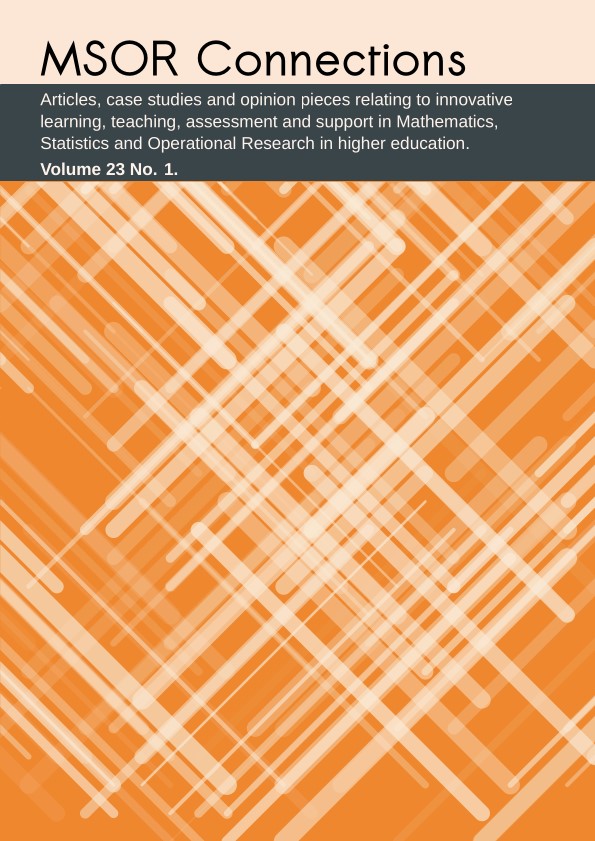How important is community to mathematics and statistics distance learners?
DOI:
https://doi.org/10.21100/msor.v23i1.1493Keywords:
Community, Sense of Belonging, Distance learningAbstract
Being part of a community has been shown to support the development of academic resilience, promote retention and improve attainment. This paper discusses the findings of a study which investigated the importance and experience of student communities for distance learning students currently studying mathematics and statistics modules. It was found that community with students on the same module or on similar degrees was the most important, whilst community with students in the same faculty; at the same university; with similar characteristics and with students in general were less valued. The proportion of students that felt community was important was significantly higher than those that felt part of a community. Students near the end of their degree felt community within a module was more important than students who had recently started, but felt other community groups were less relevant. Equally, students near the end of their degree were more likely to feel part of a community with others studying the same module than students at the start of their degree. Qualitative responses reinforced the priority of community with students on the same module but indicated a significant proportion of students had no interest in community, and there was notable variation in student views on how community could be generated.
References
Apps, T., Beckman, K. and Cronin L.( 2022) It takes more than an interest in STEM: students’ experience of transition to study in STEM disciplines at university, Research Papers in Education, DOI: 10.1080/02671522.2022.2135015
Barber, W., van Oostveen, R. and Childs, E. (2019) ‘Situating Resilience, Grit and Growth Mindset as Constructs of Social Presence in the Fully Online Learning Community Model (FOLC)’, European Conference on e-Learning. Kidmore End: Academic Conferences International Limited, pp. 65–XI
Campbell, A., Gallen, A., Jones M.H., and Walshe, A.( 2019) The perceptions of STEM tutors on the role of tutorials in distance learning, Open Learning: The Journal of Open, Distance and e-Learning, 34:1, 89-102, DOI: 10.1080/02680513.2018.1544488
Cançado, L., Reisel, J. and Walker, C. (2018) Impact of first-year mathematics study groups on the retention and graduation of engineering students, International journal of mathematical education in science and technology 49.
Chang, S.-H.H. and Smith, R.A. (2008) ‘Effectiveness of Personal Interaction in a Learner-Centered Paradigm Distance Education Class Based on Student Satisfaction’, Journal of research on technology in education, 40(4), pp. 407–426.
Cox, B. and Bidgood, P. (2002) Widening participation in mathematics, Statistics and Operational Research. MSOR Connections 2(1) DOI:10.11120/msor.2002.02010015
Croft, A.C. and Grove, M.J. (2006) Mathematics Support: Support for the specialist mathematician and the more able student. MSOR Connections, 6(2), pp.39-43.
Crosling, G., Heagney, M. and Thomas, L. (2009) Improving Student Retention in Higher Education: Improving teaching and learning. In Australian Universities’ Review, Vol.51, No. 2.
Davison, R. and Croft, A. (1999) Mathematics for Engineers: A Modern Interactive Approach. London: Addison Wesley.
Ellis, C. K. S. and Berry, B. (2012) Learning communities: their effects on college mathematics students, International journal of learning 18 (11), p 298
Foster, E., Lawther, S., Keenan, C., Bates, N., Colley, B. & Lefever R. (2012) The HERE Project
Toolkit: Higher Education: Retention & Engagement. London: Paul Hamlyn Foundation
Hibberd, S. (2002). Mathematical modelling skills. In: P. Kahn and J. Kyle, eds. Effective learning and teaching in Mathematics & its applications. London: Kogan Page. pp.158-174.
Hilliam, R. and Goldrei, D. (2019) ‘Creating an online mathematics and statistics community of learners’, New directions in the teaching of physical sciences (Online) [Preprint], (14). Available at: https://doi.org/10.29311/ndtps.v0i14.2824.
Hilliam, R., Goldrei, D., Arrowsmith, G., Siddons, A., Brown, C. (2021) Mathematics and statistics distance learning: more than just online teaching, Teaching Mathematics and its Applications: An International Journal of the IMA, Volume 40, Issue 4, https://doi.org/10.1093/teamat/hrab012
Kaufmann, R. and Vallade, JI. (2022) Exploring connections in the online learning environment: student perceptions of rapport, climate, and loneliness, Interactive Learning Environments, 30:10, 1794-1808, DOI: 10.1080/10494820.2020.1749670
Kear, K. 2011. Online and social networking communities: A best practice guide for educators. Routledge. https://doi.org/10.4324/9780203842737
Kear, K. Chetwynd, F. and Jefferis, H. (2014) Social presence in online learning communities: the role of personal profiles. Research in Learning Technology, 22, article no. 19710.
Lahdenperä, J. and Nieminen, J. H. (2020), How does a mathematician fit in? A mixed-methods analysis of university students’ sense of belonging in mathematics, International Journal of Research in Undergraduate Mathematics Education, 6 (3).
Lowe, T., Mestel, B. and Williams, G. (2016) Perceptions of Online Tutorials for Distance Learning in Mathematics and Computing. Research in learning technology, 24(1).
Ludwig-hardman, S., & Dunlap, J. C. (2003) Learner Support Services for Online Students: Scaffolding for success. The International Review of Research in Open and Distributed Learning, 4(1).
Marzocchi, A. S. (2016) The development of underrepresented students’ sense of belonging in the mathematics community through participation in college outreach, Journal of Women and Minorities in Science and Engineering 22 (2).
McPherson, M. and Nunes, M.B. (2004) The failure of a virtual social space (VSS) designed to create a learning community: lessons learned, British journal of educational technology, 35(3), pp. 305–321.
Pawley, S. (2022) The effect of scheduling on attendance at synchronous online support tutorials in mathematics. MSOR Connections, 20(2) pp. 69–81.
Rogoff, B. (1994) Developing understanding of the idea of communities of learners, Mind, Culture, and Activity, 1:4, pp. 209-229.

